The Irish still haven’t looked dominant this season, but Notre Dame destroyed Purdue in the explosiveness battle to cement a third straight awkward win. The offense survived ghastly efficiency numbers against a bad Boilermaker defense, including many self-inflicted wounds in the passing game. Defensively, Marcus Freeman and company finally limited big plays and made Jeff Brohm’s offense one-dimensional. In nearly every phase of the game Notre Dame held a slight advantage and rode those to the most comfortable win of the year, admittedly a low bar.
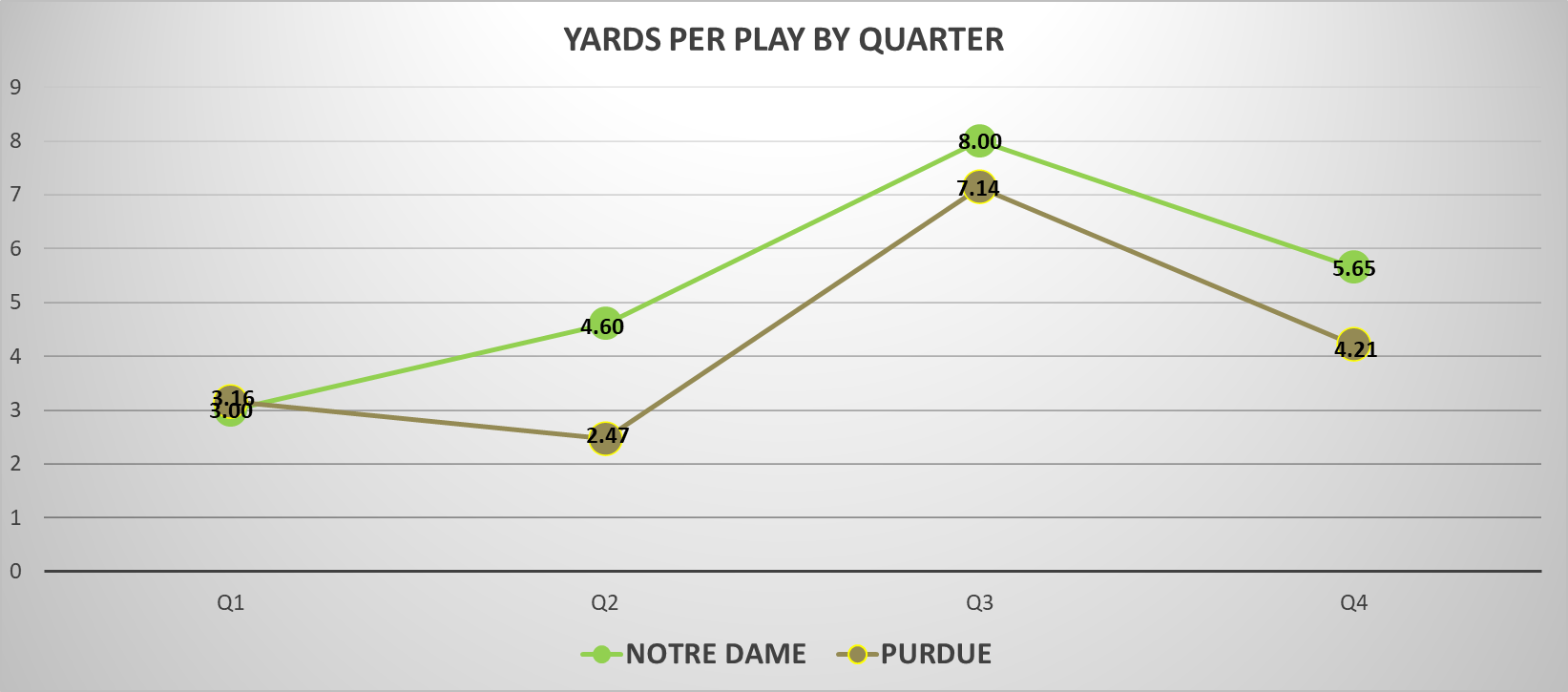
No garbage time in this game; perhaps someday a blowout (ideally of the happy variety) will cause some drives to be thrown out. The only plays excluded from the data are end of half and end of game kneel-downs.
Confused? Check out this handy advanced stats glossary here or reach out in the comments.
Explosiveness
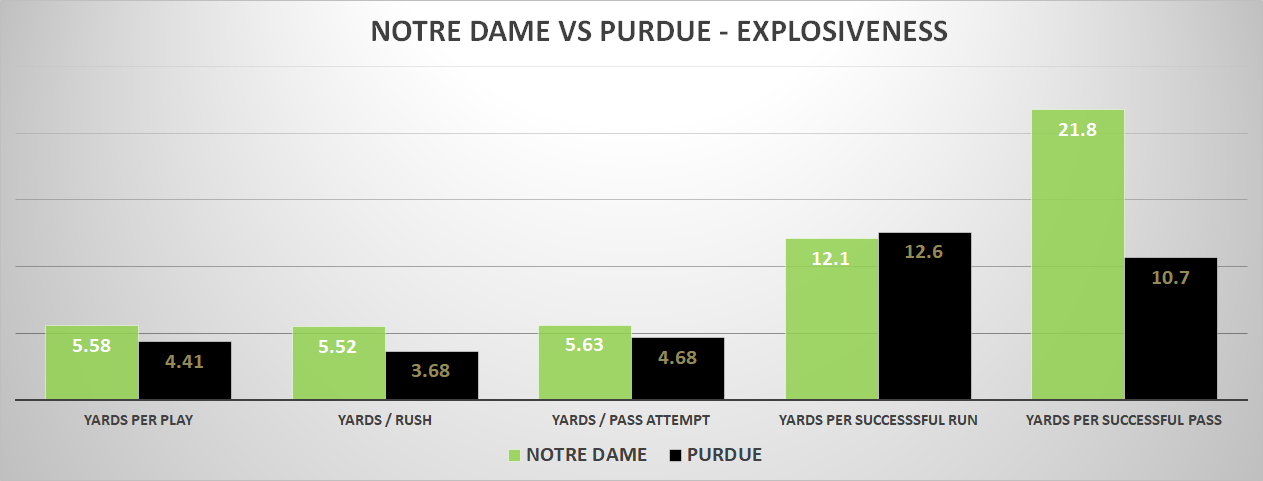
After two weeks of shutdown stretches marred by big plays, the Notre Dame defense recalibrated and found a more successful formula against Purdue. The Irish havoc rate receded to mortal levels, but it was an easy price to pay for sealing up gaps in the defense. The Boilermakers had just one gain of 10+ yards in the first half and four of 20+ yards in the game.
And while Notre Dame’s defensive disruption took a small step back, the defensive front dismantled the Purdue running game, stuffing the visitors on 36% of runs and giving up just 3.7 yards per carry. This is a game where it’s instructive to pair havoc rate (which captures the rate of tackles for a loss, forced fumbles, and passes defended) with run stuffs. The latter captures tackles for a loss against the run but also includes runs for no gain, which Notre Dame tallied six of on Saturday.
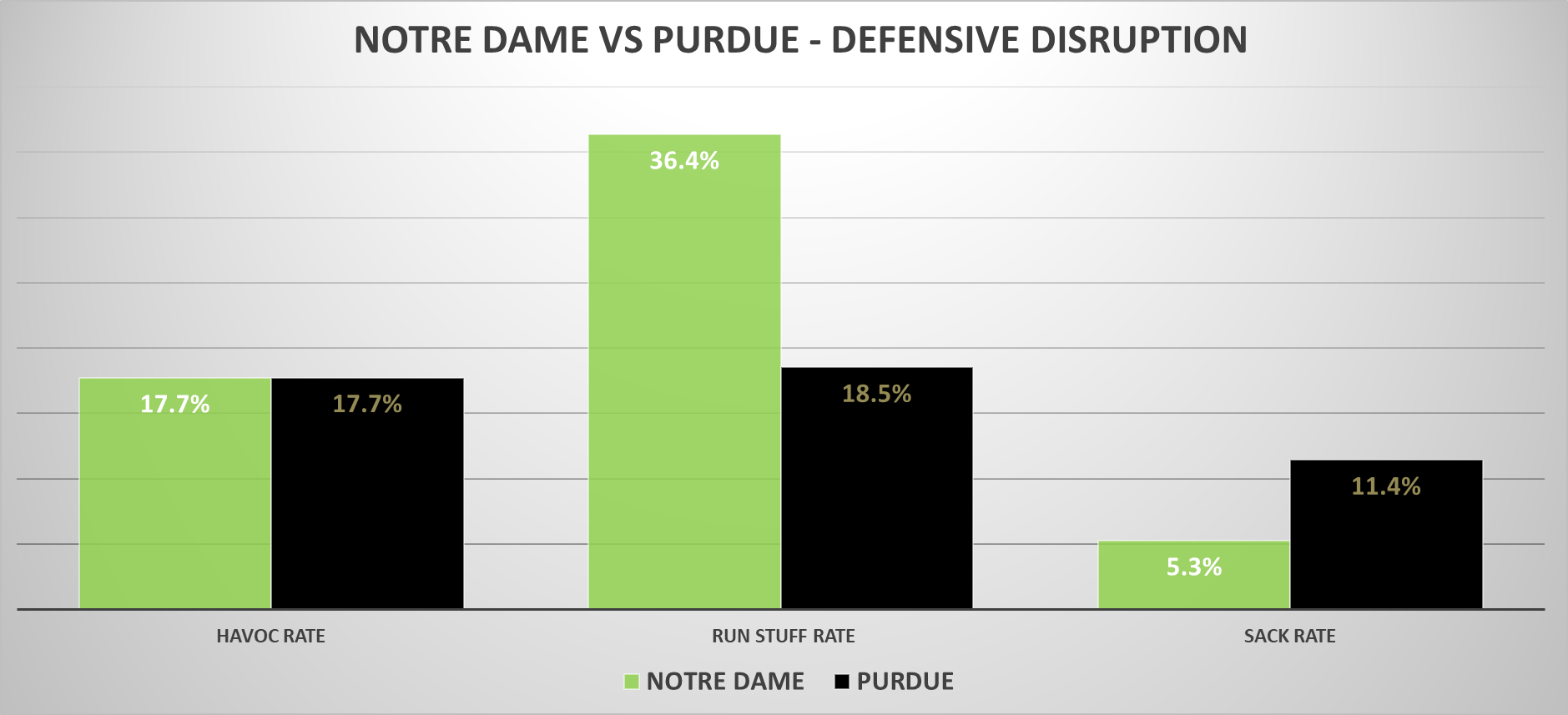
Holding Purdue under 5 yards per dropback is also nothing to scoff at – the Boilers finished ahead of Ian Book and the Irish in passer rating in 2020 and were off to a hot start in 2021 with Jack Plummer. While no one will confuse the Big Drums with the Chiefs offense (their fans may have drums?), this was a solid test against a strong offensive mind and an all-Big Ten wide receiver that Freeman won handily.
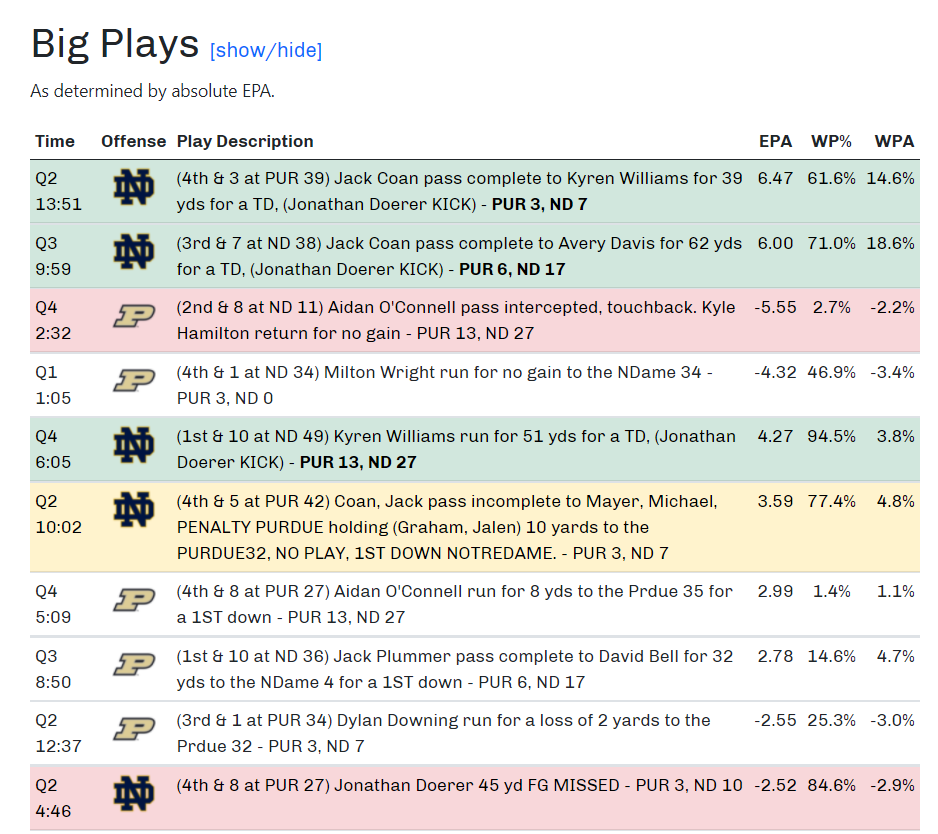
If you remember this chart from last week from Toledo, it was overshadowed by the ND offense (in a bad way, with incredibly costly turnovers). This week Tommy Rees’ unit played a cleaner game and was able to plug away until finally breaking out with three long touchdowns that tilted this game. The defense matched their effort by preventing a long Purdue counterpunch and coming away with some highlight stops – there’s about 10 points worth of Kyle Hamilton snuffing out drives in the EPA estimates.
Efficiency
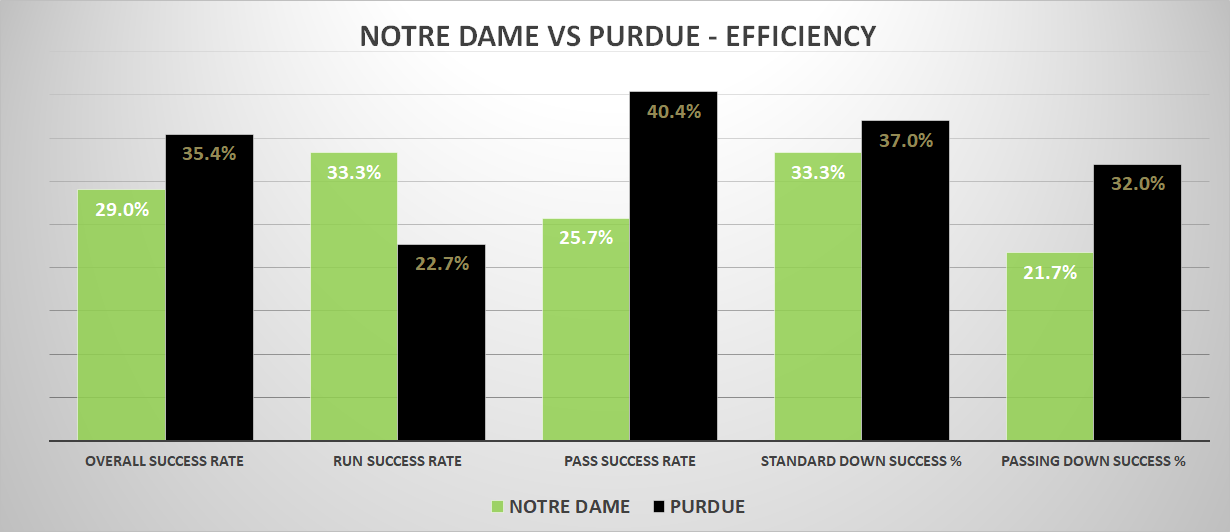
Winning the game while losing the efficiency battle has been a rare occurrence for Notre Dame – this was just the fourth instance in the last four seasons (2018 Michigan, 2019 USC, 2019 Stanford). The defensive part of the equation was solid, especially considering situational play. The Irish D allowed a 50% success rate on 18 plays that were largely harmless – Purdue’s last possession of the first half and the late fourth-quarter drive with the Boilers down two scores that ended with the Hamilton pick.
Offensively, it’s harder to spin a positive story. The rushing attack showed flashes of promise with offensive line improvement (baby steps), but still finished with its worst success rate of the season. In 27 attempts the Irish had only two runs of more than seven yards – the long Kyren Williams touchdown to ice the game and Tyler Buchner’s 20-yard run to convert a 3rd and 16. Purdue’s defensive front projects to be very mediocre despite having a George Karlaftis, so it wasn’t a promising effort leading into a stout Wisconsin defense.
The passing success rate against Purdue ….yikes. The only less efficient performances over the long Ian Book era were the 2018 playoff against a historic Clemson defense and the 2019 disaster in heavy rain in Ann Arbor. Ten first down pass attempts resulted in just two completions for 14 total yards, with two sacks. These sacks and penalties put Jack Coan up against the wall on 3rd down, where Notre Dame averaged 9.2 yards to gain and converted just 4 of 16 attempts.

The good news is that it looked far from hopeless on the field – even with the offensive line issues that feel like they will be significant all season, the Irish wide receivers were open throughout the day. Coan missed big opportunities and Kevin Austin and Braden Lenzy drops left easy points on the table. It still appears impossible for defenses to adequately defend Mayer, Austin, Lenzy, Davis, and the running backs – Rees just needs to hunt the mismatches and try to draw up things that allow Coan the time and looks to connect with them.
Still, it’s a tough task for Rees – with shaky protection and inconsistent run blocking, the offensive line is limiting hope for efficient and sustained drives. Last year 31% of Notre Dame drives were 8 plays or more in length; through three games that’s just 16% of offensive drives in 2021. The Irish offense is dependent on big plays to be successful, which requires some aggression including throwing on early downs. But those attempts currently carry a high risk of a sack or missed connection that is often drive-killing and can have field position consequences that Notre Dame can’t currently afford. The current offensive formula puts a ton of pressure on the stars to make enough big plays to carry things, and moving forward there will be fewer opportunities and an increased degree of difficulty against tougher defenses.
Finishing Drives, Field Position, & Turnovers
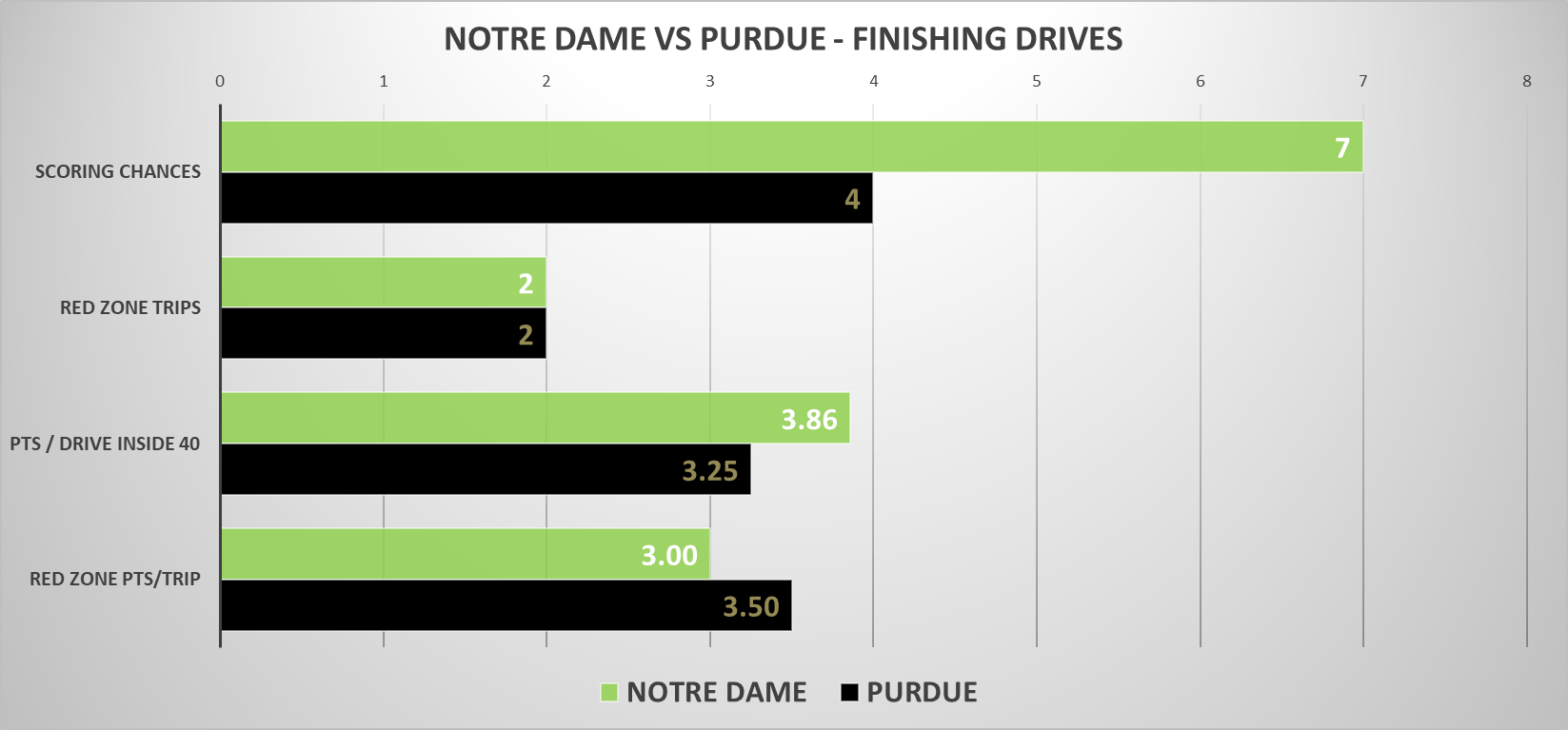
Notre Dame could have let everyone breathe a bit easier with better conversion of scoring chances, especially with the offense squandering great field position. The Irish started two drives in Purdue territory and walked away with zero points in each thanks to a shanked Doerer field goal attempt and 4th quarter drive hurt by a sack that ended in a punt from the Boilers 38. With their efficiency woes, the Irish have now scored twice as many touchdowns from outside the red zone (8) versus inside (4). It’s a shocking change of pace from 2020 when Notre Dame was far more methodical and scored 35 of 48 offensive touchdowns from in the red zone.

It was a bounceback game in the turnover department for Notre Dame, and without too much luck involved, Purdue was projected to have even more turnovers. The Irish managed to break up nine Boilermaker passes and pick off two with some beautiful plays at the end from the secondary. While Coan wasn’t at his best he generally made good decisions and erred on the side of missing where no one had a chance at the ball versus committing turnovers, so he had that going for him.
On to Wisconsin
Despite everything feeling relatively difficult for Notre Dame, the advanced stats still like the Irish as a top-25 caliber team. Some of this is preseason projections still playing a role and some is the reality that virtually every team has struggled already in this early season. What’s disconcerting though, is that in this three-game stretch against fairly weak opponents (it’s I think safe to say FSU, Toledo, and Purdue are not top-40 teams and likely closer to top-60 at best?) that Notre Dame hasn’t put together a bigger win.
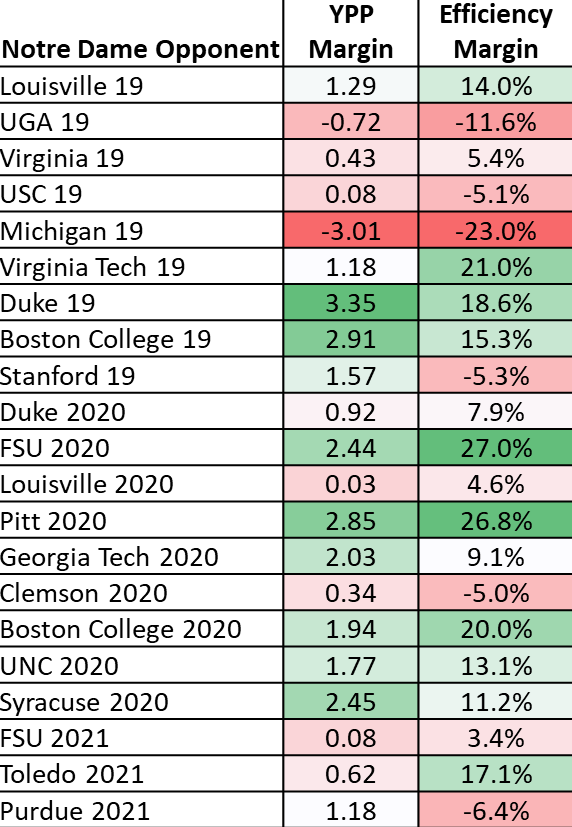
If we take a look across the last few years of regular season games, removing cupcakes, this stretch stands out negatively for 2021’s inability to separate from opponents. The most comparable recent stretch is the beginning of 2019, where the Irish had some similarly inconsistent offense and were reliant on the defense and timely plays up until November. That season included the major letdown at Michigan and similar close calls against USC, Virginia (where the defense went out and won the game for a struggling offense), and Virginia Tech. Notably, the quality of competition that year was much higher than the early stretch of 2021.
Individually, you can explain away each game. Notre Dame had a monstrous efficiency advantage in Tallahassee before turtling with the lead. The Toledo game jumps into the green categories easily without one or two of the inexplicable explosive plays allowed. Connect on a couple of long bombs against Purdue and look past some garbage-y Boilers drivers and you can squint and make that look far rosier in retrospect.
But at a certain point these exceptions become the rule and this just might be a team that lives in this space, with little margin for error. There’s much that can improve – the offensive line with more experience and the return of Michael Carmody, Coan and the wide receivers syncing up, the Freeman defense making the Purdue game the new normal. But the level of competition is also on pace to ramp up dramatically. The Irish have the top-end talent to reach a much higher ceiling than what they’ve shown, but the weak links may cancel out that potential. Anything from 4-1 to 1-4 entering this defining 5-game stretch would not be surprising, and with as much analysis as we do tons will hinge on luck in these games all projected to be one-possession nailbiters.




I’m trying to temper my expectations on offense, especially with the o-line resembling a dam that is about to crack. But it is just so frustrating to see so many plays where there is pressure and Coan crumbles to the ground with the slightest bit of contact. I like that the staff is trying to fix things (e.g., rotating in Kristofic, using Alt as an additional blocker at times), but it seems like they need to shake things up a bit more.
With all of that, it certainly doesn’t help when you combine Coan missing a handful of targets with Austin acting like he was paid to throw the game by dropping every pass thrown to him. Thankfully Avery and Kyren seemed to bail out the offense!
Thanks for the analysis — it seems like we’ve been hoping for more explosiveness and now we have it (but at the expense of efficiency)
Definitely a “be careful what you wish for” with the explosive plays, eh? It’s a bit different than last year because I don’t know that they are really sacrificing efficiency right now. In 2020 taking deep shots had a downside because with the run game + short-intermediate passing game you could string together long drives. This year I just don’t think they are capable of that at all so there’s not much downside to more shot plays.
Big time agree. The only downsides to big play offense are time of possession and field position. Quick 3-and-out drives with a couple long passing attempts can really start to wear down your own defense. But those are still possible outcomes on a run, run, pass offense with low efficiency. Big plays also get you into scoring position more often and flip the field quickly when they work.
Somebody argued in favor of an Art Briles offensive scheme last week, and I think it makes sense. ND has enough talented players at skill positions that they should be able to force their opponents into nickel for 60 minutes if they choose. This would dramatically alter the challenge for our young offensive line, and it would create some interesting mismatches for Williams and Mayer. I’d love to see them establish the pass in order to run through 6-man defensive fronts, rather than the alternative. Austin and Colzie (should they choose to use him) have size to win on the outside, and Mayer should win any jump ball in the middle of the field. Lenzy and Tyree have speed to take anyone in single coverage. Davis and Williams are both guys you trust to make the catch then make someone miss.
A constant 4-wide formation plus Williams in the backfield would give Coan the time he needs to find the open man, and would make Buchner very fun to watch.
Just by the Eye Test (TM), this team is starting to remind me of a slightly better and more balanced version of 2009, which…oof.
There are things to build around and we can improve. But living and dying by the margins is a quick way to get to .500.
A few thoughts on Wisconsin:
The advanced stats LOVE the Badgers. I will deep dive into why but the very high-level explanation is their 2020 rating was very high despite their struggles and they played so few games that I believe projections still played into their final metrics. Their defense also feasted on their ’20 opponents, which was impressive but also the opposing offenses were very B1G West.
Penn State couldn’t run on them on the road (63 yards on 16 carries) but was ok passing thanks to some coverage busts and long gains (7.3 yards / drop back). Thinking about ND’s offense to date, the best path may be a very UGA 2019 like plan with just enough running to keep them honest but I don’t expect anything to be there on the ground, especially between the tackles. Badgers starting CBs are also banged up so look for some quick reads to WRs 1-on-1 and to try to stretch UW horizontally as well, getting Tyree + Kyren the ball in space rather than in congested box areas.
I think everyone is well aware of Mertz’s struggles end of last year and against Penn State (4.8 yards / dropback, two bad picks). Small sample since Wisconsin has only played 2 games but they have created only 3 plays of 20+ yards. Mertz has just one throw 30+ yards downfield and only one pass completion over 20 yards. If they have a vertical passing game, they haven’t shown it.
So it will be an interesting chess match – how much does Freeman need to be aggressive to slow down the run game? Is he confident enough to press up in man and dare UW to do what they haven’t yet? Or are they better off ensuring the big plays are contained, knowing if they can just get Wisconsin into passing downs they will be in great shape?